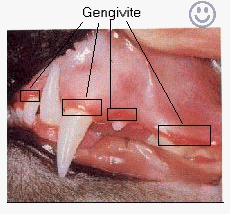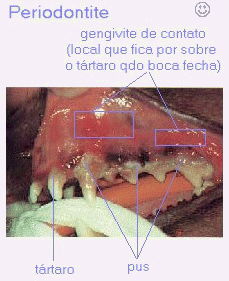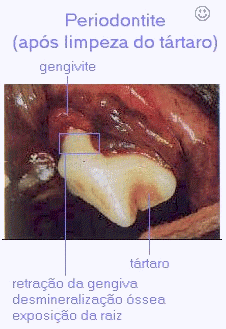DISEASES
CAUSED BY THE TARTAR IN DOGS
Many
proprietors worry about the possibility of your dogs they have decays. The one
that most of them doesn't know is that the dogs rarely present this disease that
is so common in the human being. Actually the dental problem more common of the
domestic animals (dogs and cats) it is the periodontopatia, in other words, a
disease that attacks the system of sustentation of the tooth.
 Usually,
the whole animal contains in your mouth a bacterial flora. These bacterias
adhere to the teeth forming the bacterial plate that little by little she
mineralize forming the tartar plates that with certainty all could already
observe. Some animals present tartar more or less depending on your age, diet
and mainly of your answer imunologic. It is worth to the feather to point out
that encourage of small load like Yorshire and Pinscher they possess the same
number of teeth (42 in the adult) that a Dogue Alemão; in spite of them to be
very smaller, the number of teeth seems to be too much for such a small mouth,
facilitating a larger accumulation of tartar.
Usually,
the whole animal contains in your mouth a bacterial flora. These bacterias
adhere to the teeth forming the bacterial plate that little by little she
mineralize forming the tartar plates that with certainty all could already
observe. Some animals present tartar more or less depending on your age, diet
and mainly of your answer imunologic. It is worth to the feather to point out
that encourage of small load like Yorshire and Pinscher they possess the same
number of teeth (42 in the adult) that a Dogue Alemão; in spite of them to be
very smaller, the number of teeth seems to be too much for such a small mouth,
facilitating a larger accumulation of tartar.
This
accumulation generates a favorable atmosphere for the exacerbated development of
the oral bacterias. As the number of these it increases a lot, the number of
toxicant substances produced by your metabolism it also grows in the same
proportion and then they appear Periodontopatias: Gengivit and Periodontit.
In the
gengivite there is only compromising of the gums that become red and swollen and
they can bleed to the touch. This apprenticeship is reversible and if the animal
makes a cleaning of your tartar teeth they will be clean and the gum will come
back to the normal. Already when they begin to appear infections gengivais with
pus formation, desmineralização of the bone that sustains the tooth (the root
of the tooth is apparent) and retração or disordered growth of the gum
(hiperplasia gengival), the periodontite is characterized. This apprenticeship
is irreversible and even after the treatment the animal will be with the roots
of the teeth exposed and with the reserved gum.
 The
sign more common of the periodontite it is the bad breath. The fermentation
caused by the bacterias it can together or not with the pus presence to cause a
very strong and unpleasant scent that will be noticed soon by the proprietor.
Depending on the apprenticeship of the disease the animal can be feeling pain
and with that he/she can stop feeding, to play, to gnaw your bones and to be
unhappy in a song of the house.
The
sign more common of the periodontite it is the bad breath. The fermentation
caused by the bacterias it can together or not with the pus presence to cause a
very strong and unpleasant scent that will be noticed soon by the proprietor.
Depending on the apprenticeship of the disease the animal can be feeling pain
and with that he/she can stop feeding, to play, to gnaw your bones and to be
unhappy in a song of the house.
The one
that few people know is that the largest danger of the periodontopatias is not
the loss of the teeth or the development of local infections. The bacterias that
are in the mouth of the animal are not alone for there. These fall in the
sanguine current and through her they are mischievous for all the organs of the
animal. The most affected organs are: heart, kidneys and liver and also the
articulations. If by chance the animal already has a previous lesion in some of
these places, the probability of installation of the bacterias close to them it
is very big. These bact. they cause small inflammations in the capillary of the
visceras that in the course of time form an enormous inflammation.
For
these reasons, as soon as you have a chance, verify the mouth of your cão/gato.
It doesn't yield to the temptation of waiting a little more to accumulate more
tartar and later you to order to do the cleaning. The more your time friend to
be with those plates in the mouth, more bacterias will be bombarding " your
internal organs. Studies that point the bacterias of the tartar already exist as
the most frequent accelerating of the renal and heart inadequacy in dogs.
The
treatment is simple and fast: Tartarectomia, in other words, tartar cleaning.
Always verify if the professional that will make the cleaning it possesses the
material necessary odonto. A cleaning done to thick way, eliminating the larger
plates will just do only that you feel better but it will be of little
usefulness for the animal. The largest concentration of the bacterias is in the
furrow gengival (that place where the dental thread disappears among the teeth)
that needs to be curetted manually with special instruments. And anything of
holding the animal to the force to do the cleaning. The intruments be used her
they are sharp and some pointed ones and the areas be curetted her they are of
difficult access. Imagine how your last tartar cleaning was in the dentist and
imagine the Veterinarian he/she will get to do your dog to be seat with the open
mouth, feeling the instruments working inside of the mouth and not to suffocate
with that water all of the ultrassom.
The
safest tartarectomia and well done he/she needs the support of an anesthesia.
Even the dogs with heart problems have been submitted to the this cleaning by it
anesthetizes volatile (the drug is breathed and not injected in the animal)
after they be medicated properly by your Veterinarians Cardiologics because
their risk is at the mercy of the oral bacterias it is larger than of if they
submit to the this anesthesia.
 Very
important it is also the prophylaxis work to be initiate after the cleaning.
Talk with your Veterinarian for us to reach the conclusion of which is the
method that is more appropriate for your routine. Who has 5 Rottweillers super
aggressive it won't brush their teeth a week never three times. But is it
necessary same to brush dog tooth? If you want to delay the accumulation of the
tartar in the teeth of your animal, it is. The only way holds of removing the
bacterial plate of the teeth it is the attrition caused by the toothbrush. It
was not still invented more efficient. The ideal is that after the cleaning you
get to brush the teeths of your dog/cat at least three times in the week
and with soft brush and he/she grazes on canine. Never use cream dental human,
these it contains soaps that make that whole foam and that healthy very noxious
to the stomach of the animals. Or did you think your dog will rinse the mouth
with water and to spit?
Very
important it is also the prophylaxis work to be initiate after the cleaning.
Talk with your Veterinarian for us to reach the conclusion of which is the
method that is more appropriate for your routine. Who has 5 Rottweillers super
aggressive it won't brush their teeth a week never three times. But is it
necessary same to brush dog tooth? If you want to delay the accumulation of the
tartar in the teeth of your animal, it is. The only way holds of removing the
bacterial plate of the teeth it is the attrition caused by the toothbrush. It
was not still invented more efficient. The ideal is that after the cleaning you
get to brush the teeths of your dog/cat at least three times in the week
and with soft brush and he/she grazes on canine. Never use cream dental human,
these it contains soaps that make that whole foam and that healthy very noxious
to the stomach of the animals. Or did you think your dog will rinse the mouth
with water and to spit?
In the
next article I will order larger details on the need of the escovação and a
daily program for you to accustom your animal to leave and to like of brushing
the teeth.
The veterinary doctor's collaboration Dra. Claudia Youle
of DentalVet - specialized in treatments odontológics.
The
pictures published in this article they were removed by the author of the book
" the color Atlas of Veterinary Dentistry & Oral Surgery " of
Peter Kertesz Publisher Wolfe and of the book " Small Animal Dentistry
" of Harvey and Emily.
 Usually,
the whole animal contains in your mouth a bacterial flora. These bacterias
adhere to the teeth forming the bacterial plate that little by little she
mineralize forming the tartar plates that with certainty all could already
observe. Some animals present tartar more or less depending on your age, diet
and mainly of your answer imunologic. It is worth to the feather to point out
that encourage of small load like Yorshire and Pinscher they possess the same
number of teeth (42 in the adult) that a Dogue Alemão; in spite of them to be
very smaller, the number of teeth seems to be too much for such a small mouth,
facilitating a larger accumulation of tartar.
Usually,
the whole animal contains in your mouth a bacterial flora. These bacterias
adhere to the teeth forming the bacterial plate that little by little she
mineralize forming the tartar plates that with certainty all could already
observe. Some animals present tartar more or less depending on your age, diet
and mainly of your answer imunologic. It is worth to the feather to point out
that encourage of small load like Yorshire and Pinscher they possess the same
number of teeth (42 in the adult) that a Dogue Alemão; in spite of them to be
very smaller, the number of teeth seems to be too much for such a small mouth,
facilitating a larger accumulation of tartar. The
sign more common of the periodontite it is the bad breath. The fermentation
caused by the bacterias it can together or not with the pus presence to cause a
very strong and unpleasant scent that will be noticed soon by the proprietor.
Depending on the apprenticeship of the disease the animal can be feeling pain
and with that he/she can stop feeding, to play, to gnaw your bones and to be
unhappy in a song of the house.
The
sign more common of the periodontite it is the bad breath. The fermentation
caused by the bacterias it can together or not with the pus presence to cause a
very strong and unpleasant scent that will be noticed soon by the proprietor.
Depending on the apprenticeship of the disease the animal can be feeling pain
and with that he/she can stop feeding, to play, to gnaw your bones and to be
unhappy in a song of the house. Very
important it is also the prophylaxis work to be initiate after the cleaning.
Talk with your Veterinarian for us to reach the conclusion of which is the
method that is more appropriate for your routine. Who has 5 Rottweillers super
aggressive it won't brush their teeth a week never three times. But is it
necessary same to brush dog tooth? If you want to delay the accumulation of the
tartar in the teeth of your animal, it is. The only way holds of removing the
bacterial plate of the teeth it is the attrition caused by the toothbrush. It
was not still invented more efficient. The ideal is that after the cleaning you
get to brush the teeths of your dog/cat at least three times in the week
and with soft brush and he/she grazes on canine. Never use cream dental human,
these it contains soaps that make that whole foam and that healthy very noxious
to the stomach of the animals. Or did you think your dog will rinse the mouth
with water and to spit?
Very
important it is also the prophylaxis work to be initiate after the cleaning.
Talk with your Veterinarian for us to reach the conclusion of which is the
method that is more appropriate for your routine. Who has 5 Rottweillers super
aggressive it won't brush their teeth a week never three times. But is it
necessary same to brush dog tooth? If you want to delay the accumulation of the
tartar in the teeth of your animal, it is. The only way holds of removing the
bacterial plate of the teeth it is the attrition caused by the toothbrush. It
was not still invented more efficient. The ideal is that after the cleaning you
get to brush the teeths of your dog/cat at least three times in the week
and with soft brush and he/she grazes on canine. Never use cream dental human,
these it contains soaps that make that whole foam and that healthy very noxious
to the stomach of the animals. Or did you think your dog will rinse the mouth
with water and to spit?